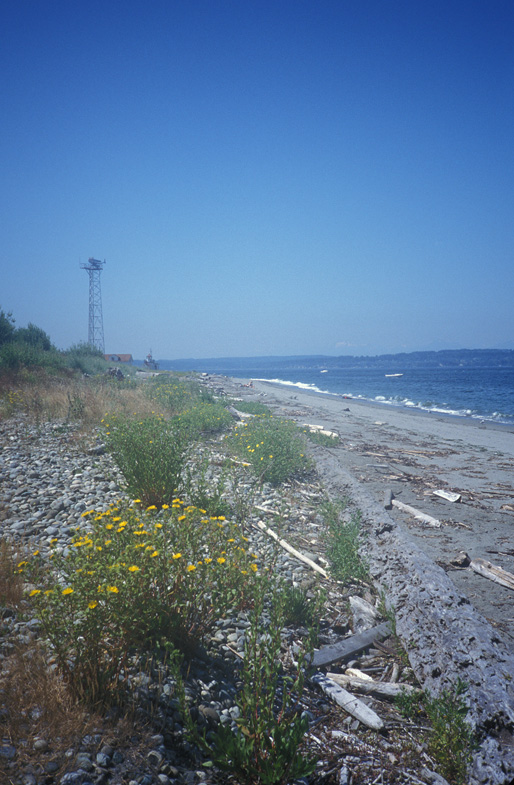
|
Saltwater Beach Plants
|
| Greater Seattle is ranked 14th largest of U.S. metropolitan areas in
the 1990 census. Of the top 40 such areas, Seattle is one of only 12
with saltwater access; 28 cities have only freshwater. The presence of
Puget Sound and Lake Washington give Seattle a great benefit, the best of
both watery realms. |
| Seattle's saltwater shoreline features diverse beaches and
geologic features: beaches of sand, gravel or boulders; cliffs and tidelands.
Moreover, there are plants which grow largely or only near the saltwater.
I'm not referring to seaweeds, but land plants which evidently thrive in
the saline, sunny, windswept conditions prevailing on beaches. |
| As I sit on bleached driftwood, running warm sand between
my fingers, listening to the waves rolling ashore, staring at the spacious
vista, a study of the plants reminds me that the shoreline is indeed the
midpoint between two worlds --marine and terrestrial. |
| Dr. Robert Van Pelt of the U.W. College of Forest Resources,
is working on a detailed map of western Washington's vegetation zones
or plant communities --as they existed before European settlement
here. He has 31 such zones, and the Seattle area features 13 of them. Five
of these 13 zones are related directly to saltwater: saltwater itself, that
is Puget Sound; tidal flats, estuaries, beaches, and dune communities. |
| If you go to a Seattle saltwater beach you will find some
distinctive plants. There's a very pretty, robust grass with broad, baby-blue
leaves, called dune grass or blue beach wild rye
(Elymus mollis). It only grows here. A relative of the garden sweet-pea which only grows on beaches
is the beach pea, Lathyrus japonicus--it grows all around the Pacific
Ocean. Puget Sound gumweed (Grindelia
integrifolia = G. stricta) is not a beach exclusive, but its gummy and attractive bright yellow flowers are most frequently
seen there. Silver burweed (Ambrosia
Chamissonis) is a sprawling sagebrush-like plant with silvery-gray, deeply dissected leaves, smelling vaguely
like cinnamon or nutmeg if squished, with densely clustered tiny
flowers which become spiny burs. All these are natives. A non-native
plant mostly found near saltwater is seaside mayweed
(Matricaria maritima), a chamomile relative from Europe with pretty daisy flowers an inch
or two wide, yet scentless foliage. A rare, tiny little plant called brass
buttons (Cotula coronopifolia) is from South Africa and grows here almost
only by saltwater, its golden flowers recalling little brass buttons. |
Seattle's beaches vary greatly in plant diversity. The best is
Golden Gardens. Discovery Park, although much larger, has a relatively
poor showing of interesting saltwater plants, especially natives, and is
contaminated by at least 8 species of non-native wildflowers sown there.
|
(originally published in The Seattle Weekly, August 1997)
Back |
|
|

